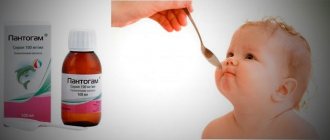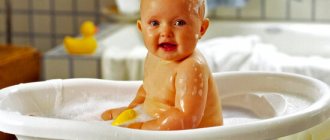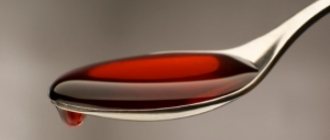Pantogam is a nootropic drug. This is the name given to drugs that affect higher brain functions. Prescribing such medications to a child worries parents: how safe is it to be treated with them? After all, not every intervention in the central nervous system remains without a trace. Let's figure out what children get more from Pantogam - benefit or harm.
Pantogam is used for neurological problems.
Effect of the drug
In the instructions for use, the action of Pantogam is described as nootropic and anticonvulsant, i.e. this medicine:
- stimulates mental activity, motivating the child to understand the world around him and improving mental abilities;
- normalizes the psycho-emotional state and ensures complete rest during sleep;
- prevents the development of convulsive conditions;
- promotes the preservation of nerve cells;
- restores damaged neurons and stimulates the formation of new ones;
- improves cerebral circulation and promotes the removal of glucose breakdown products;
- protects the brain from hypoxia and the influence of toxins.
The advantage of Pantogam is that the chemical formula of the active substance - calcium salt of hopantenic acid - is close in appearance to vitamin B5. Therefore, the body perceives the main active component as a useful element and does not prevent its penetration into the nervous structure. The constituent elements of the drug do not disintegrate internally and do not combine with other substances. Therefore, they are quickly (within two days) excreted in urine and feces.
The drug is prescribed for speech delay, communication and learning delays.
Indications for treatment Pantogam
The versatility of the active component of Pantogam allows the drug to be used to treat a wide range of diseases of the central nervous system. The product is approved for children from 12 months (sometimes from birth).
The medicine is prescribed for:
- disorders of cognitive activity and organic brain lesions;
- disorders caused by traumatic brain injury and neuronal infections;
- schizophrenia combined with organic cerebral insufficiency;
- epilepsy accompanied by mental retardation;
- urinary incontinence, the cause of which is neurogenic in nature;
- mental and emotional overload, leading to a decrease in mental and physical abilities;
- behavioral and mental development disorders;
- cerebral palsy;
- various types of hyperactivity;
- perinatal encephalopathy (manifested by hypertonicity or hypotonicity of muscles, an overly excited or depressed nervous system);
- delays in the formation of the psyche and disorders of the child’s psychological status;
- speech disorders and delayed development of schoolchildren’s skills (counting, reading and writing);
- extrapyramidal disorders (impaired motor activity of a neurological nature - progressive myoclonus, Parkinson's and Wilson-Konovalov's disease);
- cerebrovascular insufficiency (impaired blood supply to the brain due to atherosclerosis);
- extrapyramidal syndrome developed during treatment with antipsychotic drugs.
Indications for the use of Pantogam in newborns
Pantogam medicine for infants is prescribed in the following cases:
- Various disorders caused by oxygen starvation of the brain (birth injuries, hypoxia). When taking the medicine, oxygen circulation in the body increases, which allows normalizing oxygen metabolism in the brain, among other things.
- Nervous tics. This disorder occurs as a result of oxygen starvation, and taking HAC helps normalize oxygen metabolism in the body.
- Mental development disorder. Hopantenic acid slightly increases the speed of information processing in neurons, which helps restore the baby’s mental development.
- Speech and motor disturbances, as well as increased excitability. These disorders usually appear due to metabolic disorders in the spinal cord. When using pantogam, metabolism is normalized, which leads to normalization of speech and motor activity.
- Organic urination disorder. This disease appears during oxygen starvation of the spinal cord and brain, and taking GAK allows you to restore oxygen metabolism.
- Sleep disorders (restlessness during sleep, lack of sleep, inability to fall asleep). Pantogam for newborns has a calming effect; this medicine is used to treat sleep disorders.
Composition and release forms of the drug
Pantogam is available in two forms:
- Transparent syrup without color or with a yellow tint and the smell of cherry 100 mg/1 ml (active ingredient content in 1 ml of medicine) in dark 100 ml bottles.
- White round flat tablets of 250 or 500 mg (5 blisters of 10 pieces in a cardboard pack).
Tablets are suitable for children over three years of age.
Pantogam syrup is recognized as effective only for treating children under 3 years of age. Older children are advised to take tablets because this form of medication is better absorbed.
| Component name | Syrup | Pills |
| Calcium hopantenate | + | + |
| Calcium salt of stearic acid (E572) | — | + |
| Methylcellulose (E461) | — | + |
| Magnesium carbonate (E504) | — | + |
| Talc | — | + |
| Glycerin (E422) | + | — |
| Sorbitol (E420) | + | — |
| Citric acid (E330) | + | — |
| Sodium salt of benzoic acid (E211) | + | — |
| Aspartame (E951) | + | — |
| Cherry flavor | + | — |
| Distilled water | + | — |
Reviews from parents about the use of Pantogam for newborns
Ksenia Ivanova, housewife:
Victoria Vakulenko, school teacher:
“If a doctor has prescribed a medicine for a child, then I look on the Internet for reviews from doctors and other mothers. It seems to me that many parents who are not indifferent to the fate of their children do this, and familiarization with alternative points of view helps to form a comprehensive vision of the situation. Of course, you should trust doctors, but it doesn’t hurt to find out the opinions of other people either.
I think so - don’t be afraid to give pantogas to newborns. The child had many neurological disorders - decreased muscle tone, impaired step reflex, mild hypoxia, and so on. I went to the hospital and a neurologist prescribed me to drink pantogam syrup 3 times a day for 1 month. Giving the syrup is easy because it has a pleasant cherry flavor.
Irina Kulik, bank employee:
Rules for taking Pantogam
The medicine is better absorbed if taken 15-30 minutes after meals. The instructions state that:
- The minimum single dose for children is 250 mg in terms of the main active component. This corresponds to 2.5 ml of syrup or 1 tablet of 250 mg, or half of 500 mg.
- The maximum single dose is 500 mg (5 ml syrup, 2 tablets of 250 mg or 1 tablet of 500 mg).
- The minimum therapeutic dose per day is 750 mg (7.5 ml of syrup, 3 tablets of 250 mg or one and a half tablets of 500 mg).
- The maximum daily dose is 3000 mg (30 ml syrup, 12 tablets of 250 mg or 6 of 500 mg).
Half an hour before taking the medicine, the child can eat a hearty meal.
Treatment usually lasts from 1 to 4 months, sometimes up to 6. The drug is re-prescribed 3-6 months after discontinuation. The exact dosage and duration of the course is determined by the attending physician, depending on the diagnosis and the severity of the identified disease. Strictly observe the appointment time.
Scheme of drug use
Newborn babies are prescribed the drug in the form of syrup. The drug is never prescribed as a prevention of any pathology, but is a drug that solves a specific problem.
The dosage of the drug and the duration of the course depend on the following factors:
- patient's age;
- severity of the disease;
- the presence of concomitant pathologies.
The total duration of taking the drug is one...four months. Sometimes the duration of use reaches a year, but only for the treatment of serious pathologies, for example, epilepsy. If necessary, the course of treatment can be repeated. The break should be three...six months.
A single dosage is 0.25...0.5 grams. Treatment begins with a minimum dose, which is then increased to an effective dose. Abrupt withdrawal of the drug is unacceptable. It is necessary to gradually reduce the dose of the drug over the course of a week, bringing it to the original level.
For disorders related to urination, the daily norm is one...two grams, divided into three doses. Duration of therapy is one...three months.
Manufacturer: Pantogam and drug analogues
Pantogam was invented and produced in Russia. The manufacturer of the medicine is always indicated on the packaging:
The price of both dosage forms is approximately the same - they can be purchased for 350-400 rubles.
If the pharmacy does not have Pantogam, you can buy another drug with the same active ingredient.
Brief overview of analogues:
- Gopantam (about 300 rubles) - only in the form of tablets of 250 and 500 mg. It also has an analgesic effect.
- Calcium gopantheonate (200-250 rubles) - only in the form of 250 mg tablets. The drug is contraindicated in children under 3 years of age.
- Pantocalcin. Tablets 250 mg - about 450 rubles. 500 mg - 600-700 rubles. The description of side effects does not include sleep disturbances, drowsiness or noise in the head.
Synonym of Pantogam - Pantocalcin.
Pantogam for newborns: indications, application features and side effects
Pantogam is a drug with a nootropic effect. The active substance of this drug is hopantenic acid, which helps improve the absorption of oxygen by the brain and has a slight calming effect without causing drowsiness. For infants, Pantogam is available in the form of syrup, which can be given to children only as prescribed by a doctor.
Pantogam syrup for newborns is a gentle nootropic drug that has a mild sedative effect and also activates the process of oxygen absorption in the brain.
Doctor Komarovsky's opinion
Pantogam is a remedy with an ambiguous effect. While restoring some functions of the nervous system, it can cause disruption to others. Therefore, it should be given to children with caution. Carefully monitor your child’s behavior to determine whether the benefit brought by the drug outweighs the possible harm caused by the drug.
Pantogam is a Russian-made nootropic that is widely used in pediatrics and child neurology. Nootropics are drugs that have a stimulating effect on the centers of the brain that are responsible for the processes of thinking, remembering, writing and speaking. For parents of young patients, it is important to know why the medicine Pantogam is used in treating children, how much it costs, how to give Pantogam to infants correctly and in what form, what is better for babies - syrup or tablets. Let's look at the answers to the most pressing questions in this article.
Pantogam: instructions for use for children
According to the register of medicines (RLS), Pantogam is available in tablet form of 250 and 500 mg, in the form of capsules of 300 mg and 10% syrup. Among all liquid dosage forms (tinctures, drops, suspensions), syrup is preferable for children. It has a pleasant taste, not too thick consistency and does not contain ethyl alcohol.
1 ml of 10% Pantogam syrup contains 100 mg of the active substance - calcium salt of hopantenic acid. Excipients: 258 mg glycerol, 1 mg each of citric acid monohydrate and sodium benzoate, 150 mg sorbitol, 0.5 mg aspartame sweetener, 0.1 mg cherry flavor. These components are diluted with purified water.
In total, the bottle contains 100 ml of syrup in the form of a transparent, slightly yellowish liquid.
Hopantenic acid accelerates the transmission of impulses from one brain cell to another, due to this, new information is absorbed and memorized faster, it is retained in memory longer and is easier to reproduce. In addition, Pantogam has a number of other positive effects on the body:
- calms, suppresses anxiety;
- regulates the process of urination;
- relieves cramps;
- increases the survival of nerve cells under conditions of oxygen starvation;
- normalizes behavior in mental disorders.
Pantogam in the form of syrup is well absorbed in the digestive tract and is delivered to the brain through the bloodstream. It accumulates in small amounts in other organs and tissues. Hopantenic acid does not interact with chemical compounds in the body and is excreted unchanged in urine and feces.
Why is Pantogam prescribed to children? The list of indications for its use is quite extensive:
- perinatal encephalopathy (PEP) is a brain pathology that develops in a child in utero or during delivery due to oxygen deficiency;
- any form of cerebral palsy (CP);
- delayed speech development (SDD), reading and writing, any speech disorders - from stuttering to its complete absence;
- slower motor and mental development;
- hyperkinesis – involuntary movements of individual muscle groups;
- seizures;
- mental illness with behavioral and thinking disorders;
- Attention deficit hyperactivity disorder (ADHD) – uncontrollable impulsiveness in a child that prevents him from concentrating;
- consequences of inflammatory or traumatic brain damage;
- neuroses – instability of the nervous system;
- psycho-emotional, mental overload in schoolchildren, stress;
- pathology of urination (nocturnal, involuntary, frequent), associated with a violation of the nervous regulation of this process.
Experts' opinions
Nadezhna Berezina, pediatrician of the highest category:
“For newborns, the medicine pantogam is prescribed to stimulate brain functions. The medicine is also prescribed to normalize sleep. The active substance stimulates oxygen metabolism, which helps improve the natural circulation of oxygen in the brain. Pantogam is prescribed to babies from birth, and the optimal form of release for children is syrup with a slight cherry flavor.
Vladimir Dlin and Natalya Guseva, employees of the Institute of Obstetrics and Pediatrics:
Pantogam: reviews for children
On forums for parents you can find very diverse opinions about Pantogam. Many point to the effectiveness of the drug for nervous and mental illnesses, but note frequent adverse reactions due to its use. As a rule, children experience increased agitation and anxiety, and allergic reactions are observed somewhat less frequently.
Other parents indicate in reviews that they would not give Pantogam to their children, since this is a remedy with unproven effectiveness and a high risk of complications. Neurologists generally do not support this idea, since they see positive changes in patients when taking Pantogam.
Side effects
Typically, the drug in syrup form is well tolerated by patients, but in children with increased individual sensitivity to the components of the drug, some side effects may occur while taking it:
- from the digestive system - abdominal pain, nausea, rarely vomiting, salivation, bloating, flatulence, problems with stool;
- from the nervous system - increased nervous excitability, insomnia, irritability, in some cases, on the contrary, drowsiness, lethargy and apathy;
- on the skin - urticaria-type rash, dermatitis;
- allergic reactions - in rare cases, the development of angioedema and urticaria.
Pantogam for children: reviews - Komarovsky
Dr. Komarovsky, a famous Ukrainian pediatrician with many years of experience, considers Pantogam to be a safe, but ineffective remedy. The drug has not undergone large-scale clinical studies that would confirm its effectiveness. It is prescribed, as a rule, to reassure the baby’s mother and create the appearance of active treatment. Moreover, most situations that become a reason for using Pantogam resolve spontaneously without any external intervention.
Regarding medications based on hopantenic acid, Komarovsky says that they cannot be prescribed to infants under one year of age on an outpatient basis, like other nootropics. First, such drugs are given in a hospital under constant medical supervision. Only if they are well tolerated after discharge can they be recommended for further use.
Release form and pharmacokinetics of the drug
The main effect of this drug is to increase the brain's resistance to oxygen starvation and reduce its exposure to toxic substances. Has anticonvulsant, sedative, mild sedative effect. It is able to stimulate the desire to learn, to learn something new, it affects vocabulary (it is able to use the areas of the brain responsible for the development of speech).
The drug has been used in neurological practice since 1979. Since then, pharmacists and neurologists have managed to study the action, possible side effects and drug interactions of the drug quite well. To this day, this nootropic remains one of the most effective and widely prescribed.
Interaction with other drugs
The drug should be prescribed with caution with barbiturates and anticonvulsants. This is due to the fact that the syrup prolongs the duration of the therapeutic effect of these drugs, resulting in an increased risk of side effects and overdoses. When this drug is used simultaneously with antipsychotics, the risk of developing side effects of the latter is reduced. With the simultaneous use of syrup with Glycine and medications based on etidronic acid, the therapeutic effect of Pantogam is enhanced. Under the influence of this drug, the effect of local anesthetics (procaine) is potentiated.
Indications for use
The drug is used mainly in neurology and sometimes in psychiatry. Regardless of the scope of application, there are mostly positive reviews about this medicine.
- violations of basic brain functions - memory, intelligence, speech, attention;
- consequences of organic brain damage due to hypoxia or traumatic brain injury, neuroinfections;
- cerebral circulatory disorders due to changes in blood vessels;
- impaired motor activity due to hepatolenticular degeneration, Parkinson's and Huntington's diseases;
- extrapyramidal disorders during treatment with antipsychotic drugs;
- a period of high mental and physical stress on the body;
- problems with bowel and bladder emptying of a neurogenic nature.
What side effects can it cause?
Most often, they reach such strength and intensity that parents give up and simply stop taking the pills, interrupting the course. This happens mainly due to an incorrectly prescribed dosage. The doctor must take into account not only the child’s age, but also weight. For example, for a six-year-old girl weighing 28 kg, the dosage should be less than for a four-year-old boy weighing 35 kg. Also, when prescribing, you need to take into account all the nuances of the course of the disease, the child’s sensitivity to hopantenic acid, and the use of other medications.
- hyperactivity and motor restlessness, disinhibition: the child (even if he was previously calm) begins to run, jump, scream, laugh loudly and generally give the impression of not being entirely adequate;
- problems with sleep: it not only becomes difficult for a child to fall asleep, he may also wake up in the middle of the night, and then fall asleep during the day in the most inappropriate places;
- in rare cases, the gastrointestinal tract may develop pain and discomfort in the epigastric region, indigestion, diarrhea;
- increased anxiety, irritability, tearfulness;
- constant laughter, tears, hysterics for no reason.
There is a list of absolute contraindications in which taking the drug in any dosage is prohibited:
- chronic liver diseases;
- chronic renal failure;
- intolerance to hopantenic acid;
- acute psychotic states.
Parents are prohibited from prescribing dosages for their children on their own. Only an experienced neuropathologist or psychiatrist can recommend optimal doses and total duration of therapy. Otherwise, parents should not be surprised by the side effects that the drug can cause.
It is worth distinguishing between delayed mental development and delayed speech development. In the first case, the child behaves inappropriately for his age, does not feel embarrassed, and is not aware of many dangers. And delayed speech development is a discrepancy between vocabulary and age. There is a mixed form - delayed psycho-speech development, when the child lags behind in both directions. This diagnosis is usually made up to five years of age inclusive, and then either autism, mental retardation, or general speech underdevelopment is diagnosed.










